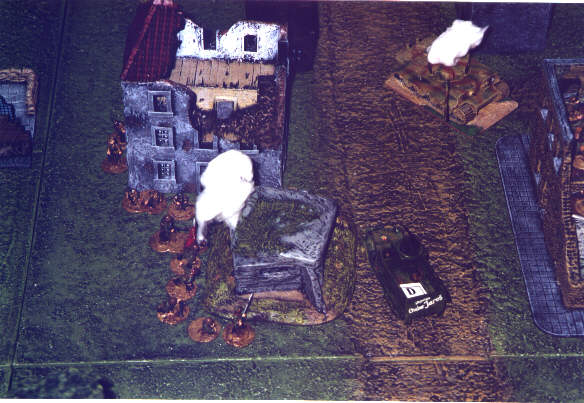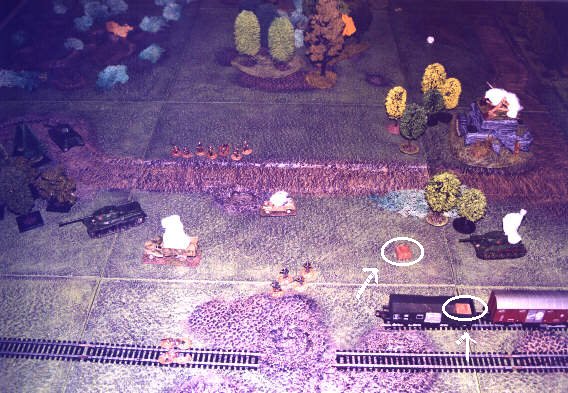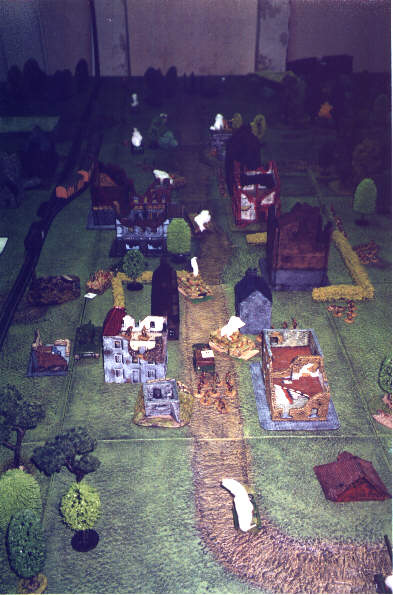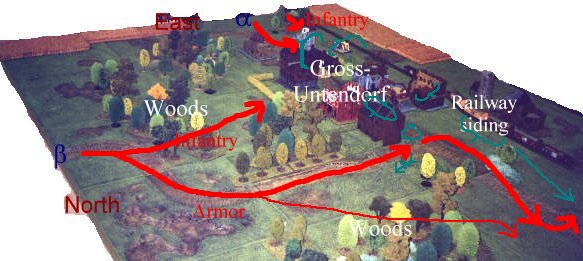

'Schild en Vriend' is an old Flemish battlecry, used in the rebellion of the city of Brugge against the French, May 18, 1302. Legend tells that it was used to differentiate between the French-speaking (who could not pronounce 'schild') and Flemish-speaking citizens. Nowadays, historians tell us that it was probably 'Des Gilden Vriend'.

...continued from part 1.
On the eastern edge of Gross-Untendorf, things were still not going well for the Russians. One M3 halftrack had fallen victim to fire from the still belligerent Hetzer and the infantry in the woods started suffering badly from incoming fire from the pillbox and house. To top it all off, the recently reappeared KVII gave a truly impressive demonstration of how to move large amounts of earth from around an opposing pillbox but managed to leave the actual pillbox completely unscathed. Disappointed with its' own performance, or lack thereof, and receiving some incoming fire from the Hetzer, the crew applied reverse thrust to the tank, again disappearing for a prolonged stint in the rear areas.
Any normal infantry would have long given in and gone home by now, but not the stalwart Russians. It was time to show everybody around how real men handled this situation. Ammunition was gathered, grenades were primed, the flag was unfurled and the order to charge was given. One company and the support weapons of the battalion promptly charged out of the safe woods and stormed into a hail of fire across open terrain towards the pillbox. The first man (and, as would become clear somewhat later, nearly the only one) to reach the pillbox hoisted his bundle of grenades and with a heart-felt 'nazdrovnje' delivered it neatly through the firing slit. One terrific explosion and several flying pieces of debris later, the pillbox was cleared. The survivors of the wild charge, still under fire from German infantry in the neighbouring house, quickly moved into the relatively safe environment of the still smoking pillbox.

| Russian infantry assaults and blows up the pillbox that had been harassing them for some time. German infantry in and around the house behind them tries but fails to stop the Russian assault. One of the two remaining Russian halftracks is aiding by giving surpressing fire on the house, while more Russian infantry can just be seen moving into the house across the street. A Tiger destroyed by air attacks the day before forms an impressive wreck in the background. |
Just as the brave Russian infantry captures the pillbox, the KVII decides to put in yet another appearance (again miraculously avoiding the lens of our war correspondent), and its' fire, combined with that from the Russian infantry across the street, makes short work of the German infantry still in the house behind the pillbox. Things were now looking very bleak indeed for the Germans. Their eastern outpost in the village cleaned up, all eyes now went to the western side of the village.
There, things were not exactly going well for them either. The second Panther, which had been called in from the east some time before, had now joined it's brother, being destroyed by well-aimed Russian tank fire. German infantry did defend themselves well against the Russian armour though, blowing up a T-34 with a rear shot of a Panzerschreck. Further to the west, a running fight had developed between the little German tank (actually a Panzer II Lynx) and a T34 and JSII, predictably resulting in one more burning German tank. But the sacrifice of this tank had not been in vain, as it enabled two trucks with precious art to get off-table before the Russian tanks closed off the exit for good.

| Russian tanks race west to close the trap, bypassing destroyed German vehicles and scattering German infantry. On the right, a T34 is burning after being brewed up by a Panzerschreck shot. Two cases of paintings remain behind (marked). |
In the village, the Hetzer that was still running about was caught between a T34 and the KVII, while the Russian infantry, after a short reorganisation, prepared to remount their halftracks to mop up German infantry resistance further west in the rail yard. At this point, the German players, recognizing the inevitable, surrendered their forces. Just as the white flags started waving, the second battalion of Russian infantry emerged from to woods at the northern edge of Gross-Untendorf, having spent the entire battle on an invigorating but otherwise quite useless nature walk.

| Examination of the two cases left by the Germans finally clued in the Russians to the German plans, although a closer look at the recovered treasure showed that it luckily did include the picture of the Fallen Madonna with the big boobies after all. Most of the Russian soldiers couldn't care less though, as they were more interested in the schnapps left by the German defenders of Gross-Untendorf. Yet another battle won for the Motherland!
Picture to the left: A panoramic view looking east to west at the end of the game. In the foreground, on the road between the first houses of Gross-Untendorf, Russian infantry is preparing to mount up in the halftrack. Towards the middle of the picture, between the railway and the hedge, the surviving German Hetzer can be seen. The smoke from many fires is a silent witness to the ferocity of the fighting that went on in the village. |
| Schematic representation of the course of the battle. Russian attacks are marked in red, while approximate German defensive positions are marked in green. | 
|
In the end, the Germans managed to get exactly half of the art pieces to safety, barely enough for the German commander to redeem himself after being suspected of involvement in the June plot to assassinate the funny-moustached Bavarian corporal. The umpire declared the game a minor Russian victory, partly because of the fact that the Russian players adhered commendably to the spirit of the game, when, although they quickly figured out what was going on when they saw the trucks being loaded, still went after the German armour first, as the actual miniature tankers would have done, instead of blowing up the trucks. Had they not done so, very few of the art pieces would have gotten off-board. But, most importantly, even though the despicable Teutons did manage to get away with a good number of paintings, the priceless painting of the Fallen Madonna with the big boobies is now safely in Russian hands!
In the after game discussion, it was agreed that dropping off the second Russian infantry battalion immediately and having it move towards the village on foot through the woods probably was a mistake, as they spent the entire game on the way to the village, only reaching it at the moment of the German surrender. The German players also made a probable mistake in splitting up their armour and anti-tank defenses instead of concentrating them on the west side of the village, where the Russian armoured attack was most likely to (and actually did) occur.
To conclude, this was a well-made, enjoyable game in which all players involved had lots of fun. Well done, Frank!
Back to first part of the battle
Back to main Schild & Vriend page

Home | This page is maintained by Bart Vetters Schild en Vriend Miniature Wargaming Club Leuven |